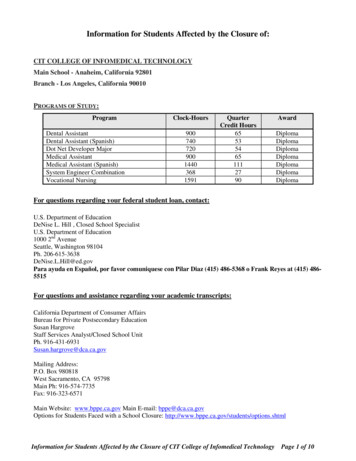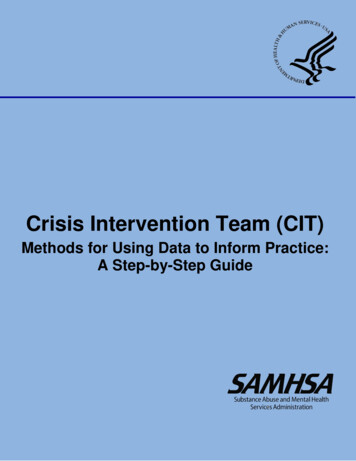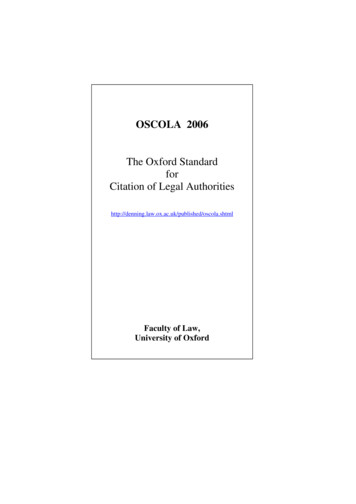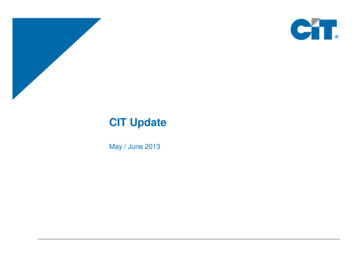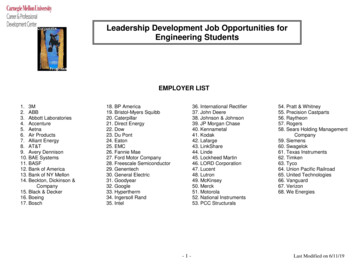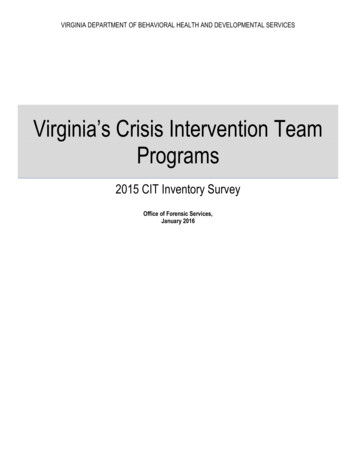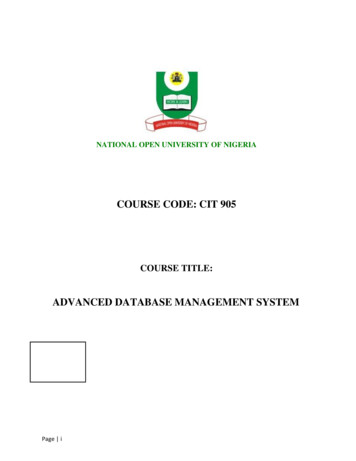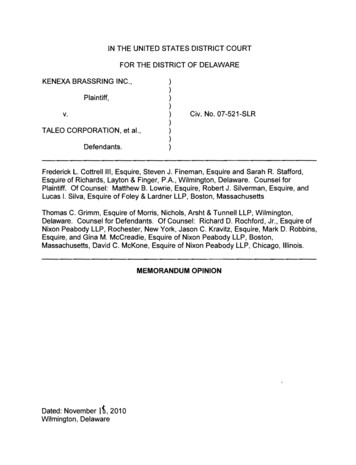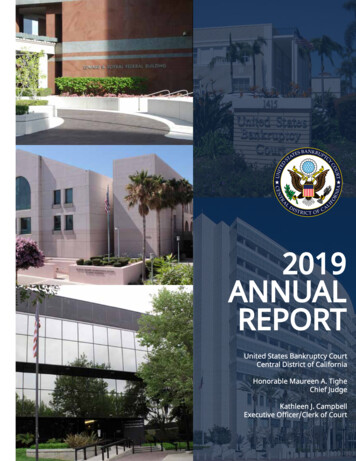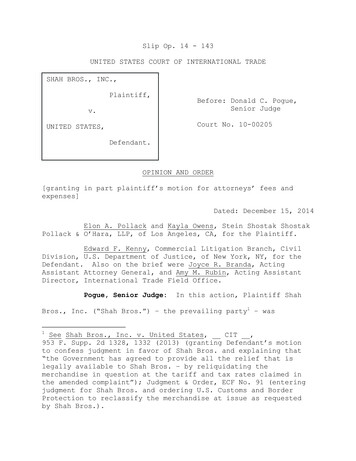
Transcription
Slip Op. 14 - UNITED STATES COURT OF INTERNATIONAL TRADESHAH BROS., INC.,Plaintiff,v.Before: Donald C. Pogue,Senior JudgeCourt No. 10-00205UNITED STATES,Defendant.OPINION AND ORDER[granting in part plaintiff’s motion for attorneys’ fees andexpenses]Dated: December 15, 2014Elon A. Pollack and Kayla Owens, Stein Shostak ShostakPollack & O’Hara, LLP, of Los Angeles, CA, for the Plaintiff.Edward F. Kenny, Commercial Litigation Branch, CivilDivision, U.S. Department of Justice, of New York, NY, for theDefendant. Also on the brief were Joyce R. Branda, ActingAssistant Attorney General, and Amy M. Rubin, Acting AssistantDirector, International Trade Field Office.Pogue, Senior Judge:In this action, Plaintiff ShahBros., Inc. (“Shah Bros.”) – the prevailing party1 – was1See Shah Bros., Inc. v. United States, CIT ,953 F. Supp. 2d 1328, 1332 (2013) (granting Defendant’s motionto confess judgment in favor of Shah Bros. and explaining that“the Government has agreed to provide all the relief that islegally available to Shah Bros. – by reliquidating themerchandise in question at the tariff and tax rates claimed inthe amended complaint”); Judgment & Order, ECF No. 91 (enteringjudgment for Shah Bros. and ordering U.S. Customs and BorderProtection to reclassify the merchandise at issue as requestedby Shah Bros.).
Court No. 10-00205Page 2previously awarded, pursuant to the Equal Access to Justice Act,28 U.S.C. § 2412(d) (2012) (“EAJA”), compensation for attorneys’fees and expenses that it had reasonably incurred.2Shah Bros.now seeks a supplemental award of the additional attorneys’ feesit incurred while litigating its EAJA application (the “feelitigation”).3Because Plaintiff is entitled to recover attorneyfees for work reasonably expended to obtain the amountpreviously awarded, Plaintiff’s motion is granted in part.Thesupplemental award is reduced to reflect excess hours and theextent of Plaintiff’s success in the fee litigation.DISCUSSIONThe prevailing party in a civil action brought by oragainst the United States is entitled to an award of the2Shah Bros., Inc. v. United States, CIT , 9 F. Supp. 3d1402, 1409 (2014) (“Shah Bros. EAJA Litig.”) (holding thatPlaintiff Shah Bros. is entitled to a fees and expenses awardpursuant to the EAJA “because Shah Bros. is the prevailing partyin this civil action brought against the United States; becausethe United States has not shown that the agency action uponwhich this civil action is based – i.e., the denial of ShahBros.’ classification protest after confession of judgment in [aprior action concerning materially-identical merchandise,imported by the same importer shortly prior to this litigation]– was substantially justified; and because the Government hasnot shown that special circumstances exist in this case thatwould make a fee award unjust”) (quotation marks and citationsomitted); see id. at 1406 (discussing the legal framework forEAJA awards). Familiarity with the facts and procedural postureof this case is presumed.3Pl.’s Supplemental Appl. for Att’y Fees Under the [EAJA],ECF No. 108.
Court No. 10-00205Page 3attorneys’ fees and other expenses incurred by that party insuch action, “unless the court finds that the position of theUnited States was substantially justified or that specialcircumstances make an award unjust.” 28 U.S.C. § 2412(d).Here,previous rulings have established that Plaintiff was theprevailing party in this civil action against the United States,and the position of the Government that gave rise to thislitigation was not substantially justified.4This “singlefinding that the Government’s position lacks substantialjustification, like the determination that a claimant is a‘prevailing party,’ . . . operates as a one-time threshold forfee eligibility,”5 such that “absent unreasonably dilatoryconduct by the prevailing party in any portion of thelitigation, which would justify denying fees for that portion, afee award presumptively encompasses all aspects of the civilaction,” including the fee litigation.6Accordingly, Shah Bros.4Shah Bros. EAJA Litig., CIT at , 9 F. Supp. 3d at 1407-08,1409 & n.13.56Comm’r, INS v. Jean, 496 U.S. 154, 160 (1990).Id. at 161 (emphasis added, quotation marks and footnoteomitted); see also id. at 162 (“Denying attorneys’ fees for timespent in obtaining them would dilute the value of a fees awardby forcing attorneys into extensive, uncompensated litigation inorder to gain any fees . . . .”) (alteration, quotation marks,and citation omitted); id. at 164 (“If the Government couldimpose the cost of fee litigation on prevailing parties byasserting a ‘substantially justified’ defense to feeapplications, the financial deterrent that the EAJA aims to(footnote continued . . .)
Court No. 10-00205Page 4is entitled to an EAJA award that includes compensation for thefee litigation.The next question before the court is thereforethe appropriate magnitude of such award.As a threshold matter, the EAJA entitles the Plaintiffto compensation only for work that was “reasonably expended.”7In this regard, the Government argues that certain entriescontained in Plaintiff’s itemized fee litigation bill8 are noncompensable.9Specifically, the Government contests entries thatreflect 1) a junior attorney working together with a senioreliminate would be resurrected.”); cf. Scarborough v. Principi,541 U.S. 401, 407 (2004) (“Congress’ aim, in [enacting theEAJA], was ‘to ensure that certain individuals, partnerships,corporations . . . or other organizations will not be deterredfrom seeking review of, or defending against, unjustifiedgovernmental action because of the expense involved.’”) (quotingH.R. Rep. No. 99-120, at 4 (1985)).7Hensley v. Eckerhart, 461 U.S. 424, 434 (1983) (“The districtcourt . . . should exclude from [the] fee calculation hours thatwere not ‘reasonably expended,’ . . . [such as] hours that areexcessive, redundant, or otherwise unnecessary.”) (quotingS. Rep. No. 94-1011, at 6 (1976)); Copeland v. Marshall,641 F.2d 880, 891 (D.C. Cir. 1980) (en banc) (“Any fee-settinginquiry begins with the ‘lodestar’: the number of hoursreasonably expended multiplied by a reasonable hourly rate. . . Compiling raw totals of hours spent, however, does notcomplete the inquiry. It does not follow that the amount oftime actually expended is the amount of time reasonablyexpended.”) (emphasis in original).8See Ex. A (supplemental EAJA application and itemized fee bill)to Decl. of Elon A. Pollack, ECF No. 108 (“Pl.’s Suppl. FeeBill”).9Def.’s Resp. to Pl.’s Supplemental Appl. for Att’y Fees Underthe [EAJA], ECF No. 109 (“Def.’s Opp’n”) at 2-5.
Court No. 10-00205Page 5attorney; 2) work on unfiled motions; 3) performance of morethan one task; and 4) preparation of the supplemental EAJAapplication.10Each argument is addressed in turn.First, the Government’s objection to thereasonableness of work performed by a junior and senior attorneyworking together11 is unpersuasive.Indeed “it is the rulerather than the exception to have a junior and senior attorneyworking together on a matter,”12 and nothing suggests anyinappropriate duplication of effort here.On the other hand,the Government is correct that no EAJA fees are recoverable forunfiled motions, and that this is the law of the case.1310Id.11See Def.’s Opp’n, ECF No. 109, at 3-4 (challenging entriesbilling for “KO” and “EAP” working together); Shah Bros. EAJALitig., CIT at , 9 F. Supp. 3d at 1411 n.21 (noting that“KO” was the most junior attorney on the team, whereas “EAP” wasthe most senior attorney).12Former Emps. of BMC Software, Inc. v. U.S. Sec’y of Labor,31 CIT 1600, 1649, 519 F. Supp. 2d 1291, 1334 (2007) (quotingRoss v. Saltmarsh, 521 F. Supp. 753, 760 n.35 (S.D.N.Y. 1981),aff’d, 688 F.2d 816 (2d Cir. 1982)); Ross, 521 F. Supp. at 760(noting that “this arrangement is the normal partner/associateor senior associate/junior associate working relationship inmost legal firms”).13Shah Bros. EAJA Litig., CIT at , 9 F. Supp. 3d at 1413(accepting the Government’s challenge to, inter alia, EAJAcompensation for work on unfiled motions, for the reasonsprovided in the Government’s annotations to Plaintiff’s initialitemized fee bill); Ex. 5 (Plaintiff’s itemized fee bill,annotated to reflect hours and rates contested by theGovernment) to Def.’s Mem. in Opp’n to Pl.’s Appl. for Att’ysFees & Expenses Under the [EAJA], ECF Nos. 96-2 & 96-3 (“Def.’s(footnote continued . . .)
Court No. 10-00205Page 6Accordingly, time spent working on unfiled motions14 shall beexcluded from Plaintiff’s EAJA award.With regard to the billing entries reflectingperformance of more than one task,15 the particular entries atissue here are not so devoid of specificity, and the billingtime blocks are not so large, as to obscure the reasonablenessof the work performed.16Only two of Plaintiff’s supplementalInitial Objections”), at 42 (challenging entries reflecting workon unfiled motions) (citing Gibson v. Colvin, No. 4:03-cv-90,2013 WL 2422611 (S.D. Ga. June 3, 2013)); Gibson, 2013 WL2422611 at *4 (“Unfiled motions, whether or not unfiled becauseof strategic judgments by counsel, cannot be compensated. Theyrepresent miscalculation by counsel and . . . mistakes will notbe compensated under the EAJA.”) (citing Hensley, 461 U.S.at 437 (cautioning that counsel must use billing judgment inhours worked)); see Hensley, 461 U.S. at 434 (quoting Copeland,641 F.2d at 891 (“In the private sector, ‘billing judgment’ isan important component in fee setting. . . . Hours that arenot properly billed to one’s client also are not properly billedto one’s adversary pursuant to statutory authority.”) (emphasisin original)).14See Def.’s Opp’n, ECF No. 109, at 4 (identifying entry numbers56, 57, 58, and 61 as pertaining to unfiled motions (as numberedin the Government’s annotated reproduction of the Plaintiff’sitemized supplemental fee bill)); Ex. 1 (Plaintiff’s itemizedsupplementary fee bill, annotated to reflect the Government’sitemized objections) to Def.’s Opp’n, ECF No. 109-1 (“Def.’sAnnotated Fee Bill”) at 5 (showing entry numbers 56, 57, 58,and 61 – comprising 2.5 hours in total – as pertaining tounfiled motions).15See Def.’s Opp’n, ECF No. 109, at 4 (challenging billingentries “attributed to more than one billing event”)16Cf. Harolds Stores, Inc. v. Dillard Dep’t Stores, Inc.,82 F.3d 1533, 1554 n.15 (10th Cir. 1996) (“‘Block billing’refers to the time-keeping method by which each lawyer and legalassistant enters the total daily time spent working on a case,(footnote continued . . .)
Court No. 10-00205Page 7billing entries exceed 3 hours,17 most contain no more than twoseparate (though often related) tasks, and each entry reflectswork reasonably expended when the time billed is considered tohave been divided evenly among the tasks listed therein.18rather than itemizing the time expended on specific tasks.”);Wise v. Kelly, 620 F. Supp. 2d 435, 450 (S.D.N.Y. 2008)(“Although not prohibited, block-billing [sometimes] makes itexceedingly difficult for courts to assess the reasonableness ofthe hours billed.”) (quotation marks and citations omitted).17Cf., e.g., Noel v. Hall, No. 3:99-cv-00649-AC,2013 WL 5376542, at *6 (D. Or. Sept. 24, 2013) (permittingblock-billed entries under three hours because, “[a]lthoughcautioning against this practice, the court may excuse thismethod when the billing period is no more than three hours”)(quoting Sterling Savings Bank v. Sequoia Crossing, LLC, Civ.No. 09-555-AC, 2010 WL 3210855, at *5 (D. Or. Aug. 11, 2010)(“[W]hile billing periods of three hours or more may be subjectto exclusion, the court is more lenient with smaller blocks oftime, which it may divide by the total number of included tasksin order to find the length of time required for each individualtask.”) (citation omitted)). Here, Plaintiff’s supplemental feebill contains two entries comprising four-hour increments, eachof which lists two arguably related tasks. See Def.’s AnnotatedFee Bill, ECF No. 109-1, at 4 (entry nos. 40 and 42) (billing4 hours each for “Review Libas case; continue preparingsubmission” and “Discuss issues with EAP; continue preparingsubmission,” respectively).18See, e.g., Def.’s Annotated Fee Bill, ECF No. 109-1, at 1(entry no. 7) (billing 0.50 hours for “[c]orrespondence withRebecca Demb re: court conference; discuss same with KO”); id.at 2 (entry no. 12) (billing 1.75 hours for “[d]iscuss[ing] feeapplication with EAP re: conference with the court; reviewbrief”); id. (entry no. 14) (billing 2.25 hours for“research[ing] case law cited in opposition; draft[ing] notesfor teleconference”); id. (entry no. 19) (billing 2.25 hours for“[p]repar[ing] for court conference; conferenc[ing] withDepartment of Justice and court re: fee award; review[ing]billing documents with KO and formulat[ing] settlementstrategy”); id. at 4 (entry no. 47) (billing 1.50 hours for“[r]eview[ing] final submission; review[ing] government(footnote continued . . .)
Court No. 10-00205Page 8Finally, with regard to Plaintiff’s claim forcompensation for time spent preparing the supplemental EAJAapplication, the Government argues that such work is noncompensable because “[a]llowing Plaintiff to continue to requestfees for work performed on supplemental applications wouldpermit a never-ending cycle of EAJA fee requests.”19But “a feeaward presumptively encompasses all aspects of the civil action”(absent unreasonably dilatory conduct by the prevailing party),20including those aspects related to the compensation to which theprevailing party is entitled.21And compensating Plaintiff fortime spent in preparing the supplemental EAJA application wouldnot “permit a never-ending cycle of EAJA fee requests” because,as Plaintiff is not permitted any further briefing on thismatter, no further work remains to be compensated.submission; adjust[ing] submission based on governmentresponse”).19Def.’s Opp’n, ECF No. 109, at 5 (quoting Belcher v. Astrue,No. 1:09cv1234 DLB, 2011 WL 3847181, at *2 (E.D. Cal.Aug. 30, 2011), rev’d in part on other grounds, 522 F. App’x 401(9th Cir. 2013)).2021Jean, 496 U.S. at 161 (emphasis added).Id.; id. at 162 (quoting Sullivan v. Hudson, 490 U.S. 877, 888(1989) (“[Where proceedings are] necessary to the attainment ofthe results Congress sought to promote by providing for fees,they should be considered part and parcel of the action forwhich fees may be awarded.”)); id. at 166 (“The purpose andlegislative history of the statute reinforce our conclusion thatCongress intended the EAJA to cover the cost of all phases ofsuccessful civil litigation addressed by the statute.”).
Court No. 10-00205Page 9But determining which of Plaintiff’s fee litigationhours were reasonably expended does not end the inquiry.Because the court must “consider the relationship between theamount of the fee awarded and the results obtained,” feelitigation awards should reflect the extent to which theapplicant was ultimately successful in such litigation.22Thuswhere (as here) the Government’s challenge to Plaintiff’s EAJAapplication resulted in the court’s recalculating and reducingthe amount of the award initially sought,23 the subsequent feelitigation award should generally reflect a reduction reasonablyproportionate to the applicant’s degree of success.2422Jean, 496 U.S. at 163 n.10 (relying on Hensley, 461 U.S.at 437); see also Wagner v. Shinseki, 640 F.3d 1255, 1260(Fed. Cir. 2011) (“Courts should look to the frameworkestablished in Hensley when calculating an appropriatesupplemental fee award.”) (citing Hensley, 461 U.S. at 435-39;Jean, 496 U.S. at 161-63); Hensley, 461 U.S. at 436 (“[T]he mostcritical factor [in calculating a fee award] is the degree ofsuccess obtained.”); cf. Wagner, 640 F.3d at 1260 n.3(explaining that “[a]lthough Hensley involved the award of feesunder the Civil Rights Attorney’s Fees Act of 1976, 42 U.S.C.§ 1988, the standards set forth for awarding attorney fees ‘aregenerally applicable in all cases in which Congress hasauthorized an award of fees to a ‘prevailing party,’” and that“[f]urthermore, although Hensley involved an initial feeapplication, the fee guidelines it provides are applicable tosupplemental fee applications as well”) (quoting Hensley,461 U.S. at 433 n.7, and citing Jean, 496 U.S. at 161-63).23See Shah Bros. EAJA Litig., CIT at , 9 F. Supp. 3dat 1411-13 (awarding fees pursuant to the EAJA but reducing boththe hourly rates and the total number of hours initiallyrequested by the applicant).24Cf. Jean, 496 U.S. at 163 n.10 (“For example, if the(footnote continued . . .)
Court No. 10-00205Page 10Here, the fee litigation proceeded, at least in part,because Plaintiff’s EAJA application was overly broad.In itsopposition, the Government correctly identified numerous entriesin Plaintiff’s itemized fee bill that were either notcompensable under the EAJA at all, or else not compensable atthe claimed hourly rates.25As a result of the Government’sGovernment’s challenge to a requested rate for paralegal timeresulted in the court’s recalculating and reducing the award forparalegal time from the requested amount, then the applicantshould not receive fees for the time spent defending the higherrate.”); Wagner, 640 F.3d at 1260 (“Because Hensley requires acourt to calibrate the amount of attorney fees to the degree ofsuccess a claimant has achieved, it is generally appropriate tomake an award of supplemental fees that is commensurate with thedegree of success obtained on the original fee application.”)(citing, inter alia, Schwartz v. Sec’y of Health & Human Servs.,73 F.3d 895, 909 (9th Cir. 1995) (affirming 50 percent reductionto supplemental fee request where the applicant had obtainedapproximately 50 percent of the fees claimed in her initial feeapplication); Thompson v. Gomez, 45 F.3d 1365, 1367-69(9th Cir. 1995) (affirming 13 percent reduction to supplementalfee request where the applicants had received 87 percent of thefees claimed in their initial fee application); Harris v.McCarthy, 790 F.2d 753, 758-59 (9th Cir. 1986) (affirming88.5 percent reduction to supplemental fee request where theapplicants had obtained only 11.5 percent of the fees claimed intheir initial fee application); Institutionalized Juveniles v.Sec’y of Pub. Welfare, 758 F.2d 897, 924-25 (3d Cir. 1985)(affirming 12.5 percent reduction to supplemental fee requestwhere the claimants did not obtain complete success on theiroriginal fee application); Mercer v. Duke Univ., 301 F. Supp. 2d454, 470 (M.D.N.C. 2004) (reducing supplemental fee award by20 percent because the initial fee request was reduced by 20percent), aff’d, 401 F.3d 199 (4th Cir. 2005)).25Shah Bros. EAJA Litig., CIT at , 9 F. Supp. 3d at 1413(“[T]he Government correctly identified the entries inPlaintiff’s itemized attorneys’ bill that are not compensable byan EAJA fee award in this case because they were related to an(footnote continued . . .)
Court No. 10-00205Page 11opposition and the ensuing fee litigation, approximately11 percent of the attorney hours Plaintiff initially claimedwere found to be non-compensable.26Accordingly, the hoursreasonably and unambiguously expended to litigate Plaintiff’scontested fee application (as documented in Plaintiff’ssupplemental fee bill, excluding the 2.5 hours spent on unfiledmotions, as discussed above) shall be reduced by 11 percent, toreflect the degree of success obtained by Plaintiff in the feelitigation.27unsuccessful separate claim; involved work not reasonablyrelated to the case; involved unreasonably vague time entries;involved clerical work billed at attorney rates; reflectedoverstaffing or duplicative work; involved work on unfiledmotions; and involved unnecessary work protracting thelitigation.”) (citation omitted).26Plaintiff submitted an itemized bill seeking compensation for729.5 hours and was granted an award reflecting 650 hours.See Ex. A (Plaintiff’s initial itemized fee bill) to Decl. ofElon A. Pollack, ECF No. 93-2, at 50; Shah Bros. EAJA Litig.,CIT at , 9 F. Supp. 3d at 1413 (granting all of theGovernment’s suggested reductions to the number of compensablehours claimed in Plaintiff’s EAJA application); Def.’s InitialObjections, ECF Nos. 96-2 & 96-3 (objecting to a total of79.5 hours claimed in Plaintiff’s itemized fee bill as noncompensable).27The Government points out that “[t]he difference between thefees that plaintiff originally requested ( 311,330.00), and thefees that plaintiff obtained following [the decision in ShahBros. EAJA Litig., CIT , 9 F. Supp. 3d 1402] ( 206,737.00),amounts to a 33% reduction of its original request,” Def.’sOpp’n, ECF No. 109, at 5-6, and argues that “any supplementalfee recovery should be similarly reduced.” Id. at 6. But the33 percent reduction reflects a reduction of both the number ofhours claimed and the claimed hourly rates, whereas themagnitude of Plaintiff’s degree of success in the fee litigation(footnote continued . . .)
Court No. 10-00205Page 12Accordingly, for all of the foregoing reasons, the 2.5hours spent on unfiled motions shall be deducted as noncompensable from the 59 fee litigation hours claimed inPlaintiff’s supplemental EAJA application,28 and the remaining56.5 compensable hours shall be reduced by 11 percent, toreflect the degree of success actually obtained in the feeis better reflected by the reduction to the claimed number ofcompensable hours, which was based on the clear over-reachcontained in the EAJA application, rather than the court’s capon the claimed hourly rates, which reflected merely a slightmodification to Plaintiff’s largely reasonable claim.Compare Shah Bros. EAJA Litig., CIT at , 9 F. Supp. 3d at1413 (accepting all of the Government’s challenges to noncompensable hours contained in the Plaintiff’s initial EAJAapplication), with id. at 1411 (accepting the Plaintiff’s claimto a special factor enhancement of the statutory cap on thecompensable hourly rate); id. (noting that evidence submitted byShah Bros. corroborates the Plaintiff’s claim that its hourlyrates were “within the range of rates customarily charged forlegal work in this field,” and noting also that the Governmentsubmitted no contradictory evidence); id. at 1412 (granting thePlaintiff compensation at hourly rates significantly above therates suggested by the Government); see Def.’s Mem. in Opp’n toPl.’s Appl. for Att’ys Fees & Expenses Under the [EAJA],ECF No. 96, at 13-15 (arguing that Plaintiff should not becompensated at rates above 125 per hour); id. at 14 (arguing,in the alternative, that Plaintiff’s hourly rates should becapped at 300 per hour). Cf. Jean, 496 U.S. at 163 (“[A]district court will always retain substantial discretion infixing the amount of an EAJA award.”); Wagner, 640 F.3d at 1261(“To be sure, a court has broad discretion in awarding attorneyfees, and is not bound, in all cases, to make an award ofsupplemental fees that is [exactly] proportionate to the degreeof success obtained on the original EAJA application.”) (citingHensley, 461 U.S. at 437). Moreover, the rates to be awardedfor the additional fee litigation hours reflect only the basicstatutory cap. See infra note 29 and accompanying text.28Pl.’s Suppl. Fee Bill, ECF No. 108, at 5 (showing total numberof hours claimed).
Court No. 10-00205litigation.Page 13The remaining 50.5 compensable hours shall becompensated at the rate of 125 per hour, in accordance with thelaw of the case.29CONCLUSIONFor the reasons provided above, Plaintiff’s EAJA awardin this case30 shall be supplemented with an additional 6,312.50.31Therefore, Defendant shall pay the Plaintiff atotal of 223,636.79 in compensation for attorneys’ fees,expenses, and costs reasonably incurred in this action.It is SO ORDERED./s/ Donald C. PogueDonald C. Pogue, Senior JudgeDated: December 15, 2014New York, NY29Shah Bros. EAJA Litig., CIT at , 9 F. Supp. 3d at 1413n.32.30See Shah Bros. EAJA Litig., CIT at , 9 F. Supp. 3dat 1414 (awarding costs and expenses in the uncontested amountof 10,586.79, and ordering the parties to submit a jointcalculation for the attorneys’ fees total, in accordance withthe compensable hours and rates specified in the court’sopinion); Parties’ Joint Statement of Amount of Fees to beAwarded to Pl. Pursuant to Ct.’s Order, ECF No. 107 (“Inaccordance with the Court’s Opinion and Order datedSeptember 18, 2014 (Slip Op. 14-109), Plaintiff and Defendanthereby submit that Shah Brothers is entitled to a fee award inthe amount of 206,737.50.”).3150.5 compensable hours at 125 per hour.
corporations . . . or other organizations will not be deterred from seeking review of, or defending against, unjustified governmental action because of the expense involved.'") (quoting H.R. Rep. No. 99-120, at 4 (1985)). 7 Hensley v. Eckerhart, 461 U.S. 424, 434 (1983) ("The district
